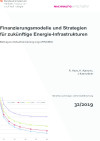Financing Models and Strategies for future Energy Infrastructures (FINAMO)
Short Description
As the "Energiewende" progresses, the dependence on fossil fuel-based technologies will decrease. While in rural areas there are many decentralised options for the use of renewable energy technologies - PV, biomass, biogas - in cities, especially in the heating/cooling sector, long-term infrastructure technologies such as networks, thermal storage and heat recovery strategies are at stake.
However, there is little willingness to invest in these infrastructures if the depreciation period is set at 15 years or less. For example, overly short-sighted economic thinking means that important long-term non-profit investments are not made. The development of suitable financing models thus plays a key role in the implementation of new energy solutions.
Within the energy system there are three key areas in which long-term financing models play an important role
- investments in renewable energy (RE) - technologies e.g. BIG Solar,
- investments in grid infrastructure for electricity, district heating, ...
- investments in the more efficient provision of energy services (Energy Performance Contracting), e.g. thermal insulation for buildings.
The above descriptions make it necessary to conduct a systematic analysis of the following questions:
- What are the basic financing models for investments in technologies with a long life or long depreciation period (also in other countries)?
- What are the most important factors and parameters influencing long-term investments?
- Which of these factors can be influenced by policies and how should this be achieved?
The most important finding from this project is that there is practically no degree of market freedom and that there are very few variables, very few „wheels to turn, in the whole system. Practically all long-term investments, e.g. in electricity or district heating networks, are located in a largely strictly regulated environment.
There are two central dimensions of boundary conditions: that of regulation and that of economic efficiency, which are related by risk. The lower the risk, the lower the expected return. Ultimately, however, the state will always have to bear the risk. The central question is: What remains of the risk for the state respectively a government?
With regard to the nature of ownership - private, public or PPP - there is no indication as to which of these forms is more suitable for long-term investment. While public companies are generally satisfied with slightly lower returns, private ones are considered more efficient. However, this is not a generally applicable and valid statement either.
Publications
Finanzierungsmodelle und Strategien für zukünftige Energie-Infrastrukturen (FINAMO)

Beitrag zur Dekarbonisierung 2050: Die Entwicklung passender Finanzierungsmodelle spielt eine Schlüsselrolle bei der Implementierung neuer Energielösungen.
Series
32/2019
Reinhard Haas, Amela Ajanovic und Jasmine Ramsebner, Energy Economics Group, TU Wien
Publisher: BMVIT
German, 79 Seiten
Publication Downloads
Project Partners
Energy Economics Group, Technische Universität Wien
- Reinhard Haas
- Amela Ajanovic
- Jasmine Ramsebner
Contact Address
TU Wien
Energy Economics Group (EEG)
Gußhausstraße 25 - 29
A-1040 Vienna
